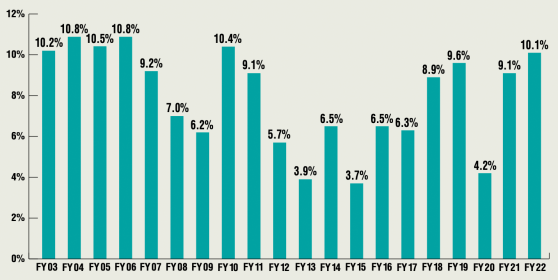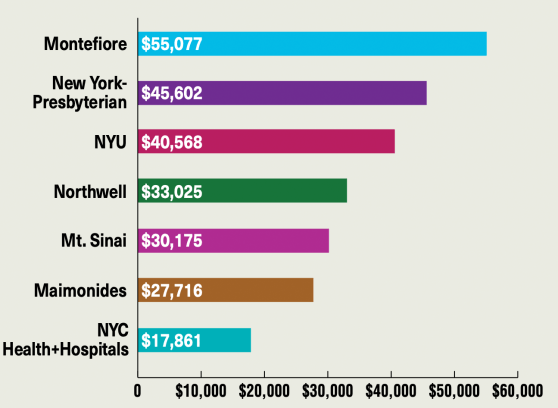Rising health care costs
Long before inflation made a comeback as a national political issue, the cost of health care was marching steadily upward, leaving unions that long ago recognized the value of good coverage battling to protect members from employer demands that they pay part of the premiums.
Starting in 2011, New York State employees had to devote part of their salaries toward health care to dodge then-Gov. Andrew Cuomo's threat to lay off 9,800 workers to balance his first budget. New York City unions including the UFT, which negotiate health care coverage under the umbrella of the Municipal Labor Committee (MLC), have held the line — but it hasn't been easy.
Over the past 20 years, according to the U.S. Bureau of Labor Statistics, national hospital costs have tripled, while other medical costs have more than doubled. The MLC recently reported that New York City's hospital industry was raising its rates by 6% to 10% annually even before the coronavirus sent hospitalizations soaring. From July 1, 2020, to June 30, 2021, the city spent not quite $3 billion on hospital bills, nearly $2 billion more than its tab just five years earlier.
The pressure on city unions was also increased by health insurance carriers significantly raising their rates. GHI, by far the most popular health plan among city employees and pre-Medicare retirees, raised its rates by an average of 7.9% annually over the past 20 years, according to data from the city's Office of Labor Relations.
"To keep the high-quality health care our members have negotiated over the years, we have to fight both the hospitals and the insurance companies," said UFT President Michael Mulgrew in summing up the situation.
Several factors contribute to the rise in health care costs well beyond the increase in the cost of living, according to Donna Lynne, the senior vice president and chief operating officer of Columbia University's Irving Medical Center.
One of the biggest factors is that people are living longer. As improvements in medical care and technology prolong lives, the cost of treating those people has risen in tandem, said Lynne, a former top official of the city's Health and Hospitals Corporation.
Prescription drug costs also continue to grow rapidly, she said, and expensive knee and hip replacements are increasingly common.
While cost may lead many people to buy their coffee at Dunkin' Donuts rather than Starbucks, Lynne continued, with health care, people are less sensitive to price when the insurance company is footing the bill and "as a patient you sometimes equate excellence with expense."
"People put in their heads that if the doctor is on Park Avenue, it's better than the doctor in the Bronx," she said.
Lynne noted that many health insurers are raising their rates this year because of the need to cover expenses incurred by their purchases of medical practices as they increasingly become providers, too. She noted that UnitedHealthcare is the nation's largest employer of physicians.
At the same time, Lynne said, "hospitals are up to their neck in labor costs" because a nursing shortage forced them to hire temps through agencies at costs far above what they pay for in-house staff. Executive pay rose, too: The typical New York City hospital CEO earned more than $1 million a year in 2017, according to a 2020 Crain's New York Business analysis of more than 60 city hospitals and health systems.
In recent years, the UFT has put pressure on New York City hospital networks such as New York-Presbyterian to reduce their charges after documenting that they billed insurance companies significantly more than some of their leading competitors. In one recent campaign, the UFT aligned with SEIU Local 32BJ in an effort to reduce hospital costs after the building-service workers union's Health Fund found stark differences in charges for similar services in the same geographic area.
The UFT and other unions statewide recently addressed another cause for concern: "surprise" medical bills that workers received after getting emergency treatment outside of their insurance network. The union-backed No Surprises Act, which took effect on Jan. 1, 2022, limits out-of-pocket costs to no more than the in-network copay or coinsurance or deductible costs.
UFT Welfare Fund Executive Director Geof Sorkin said the city and the MLC recently solicited a Request for Information to see whether another health-insurance provider can offer terms similar to those provided by the GHI Comprehensive Benefits Program for active employees and pre-Medicare retirees.
"We need to explore every single angle," he said.
Typically, when hospitals, drug plans and insurers raise their rates, employers pass along the extra charges to workers and their families. The buying power of New York City unions, Sorkin said, has enabled them to avoid saddling members with premiums while maintaining a high level of benefits that is increasingly rare in both the private sector and other municipalities.
"It's not an apples-to-oranges comparison," he said regarding smaller cities. "It's more like apples to watermelons."

